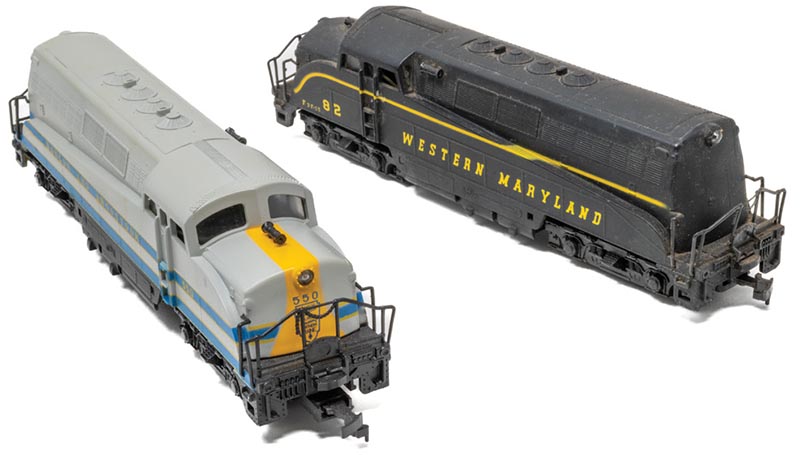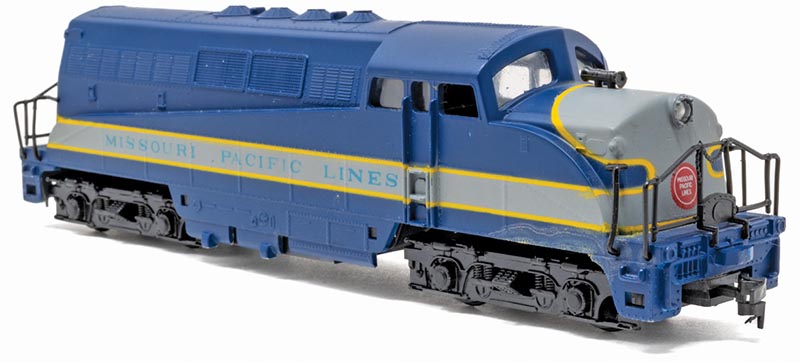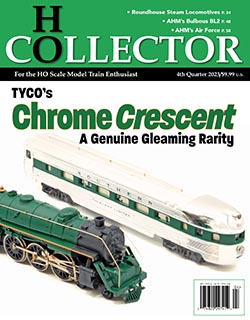Bernie Paul’s Associated Hobby Manufacturers (AHM) brought to the North American model train market an amazing variety of reproductions (mostly in HO, though the line dabbled in N, O, and HOn2-1/2). The locomotive offerings covered steam, electric, diesels, and even diesel-hydraulic prototypes. Rolling stock in AHM’s line (for the years the line was active) spanned Old-Time offerings to contemporary replicas with freight and passenger cars represented. For many years, AHM’s catalog was a full-line concern with track, electronics, structures, vehicles, figures, and more.
AHM’s First Diesel
The first new HO-scale diesel locomotive to appear under AHM’s brand debuted in 1963 and introduced a 1:87 Electro-Motive Division (EMD) BL2 to the hobby. There are at least two statements I made in that sentence with which some readers will take issue, and I’ll address one now and the other is the major reason for this article. I say this model is the first new diesel presented under AHM’s name… but what about the Fairbanks-Morse C-Liner (see HO Collector’s cover story on this model in the Second Quarter 2019 edition), you may ask? Technically, AHM did not introduce the C-Liner. The model came to the U.S. and Canadian hobby market in the early/mid-1950s boxed as a Rivarossi release and imported by New York’s Polk’s Hobbies; thus, when AHM added this C-Liner (produced in Italy by Rivarossi originally, though most came from Yugoslavia by Mehano), it wasn’t a new HO diesel locomotive. AHM’s fall 1963 release marked the line’s first 1:87 diesel locomotive that was exclusively theirs.

There again, I may have stepped into controversy using “1:87” in reference to this BL2. That’s the other area of concern and question. Given the more lax accuracy and less intricate standards of the time in which this BL2 came to market, it may not have raised a rash of comments regarding the proportions of its plastic body shell. I had my first exposure to AHM’s BL2 in the 1970s, and I recall thinking it looked a bit chunky… though the prototype was uncommon and never encountered in the wild by this young railfan. Looking at prototype BL2 images in books did suggest this AHM model had some shortcomings.
EMD’s Missing Link
The four-axle BL2 is infamous in railroading. After setting the stage for early diesels with its E- and F-units, EMD stumbled with its transi-tion to hood units in 1948. During World War II, EMD was in the enviable position of supplying railroads with its bulldog-nose F-units, while other builders saw U.S. Government guidelines limiting their output largely to switchers like Alco’s end-cab design S-series and innovative short hood/cab/long hood RS-series.

In the busy days following World War II, diesel builders were free to pursue and provide any types of product. Alco and other builders had established the short hood/cab/long hood format and it was proving to be a success in the market. In retrospect, it seems curious that General Motors designers didn’t see the obvious and move directly to this concept. EMD would strike gold with this short hood/cab/long hood platform in 1949 with the introduction of its GP7; however, there is a footnote in the line’s history occupying the year prior to the GP7’s arrival.
In early 1948, EMD rolled out its BL1 demonstrator. The unit wore an attractive deep blue with its sides showing off silver and white bands with the Electro-Motive name and red GM initials ready to show railroads the next great thing in dieselization… only it wasn’t. The single BL1 and the regular production group of BL2s didn’t excite many railroads, and even in the rabid postwar diesel market the total for both models was less than 60… this was at a time when even odd ducks from Baldwin-Lima-Hamilton had buyers ready and waiting!





